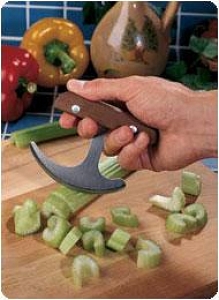| Back to Back Issues Page |
 |
|
Stroke Recovery Tips, February 2013 Issue January 29, 2013 |
Following Through With Home Exercise ProgramsMany patients participate in therapy but once they are discharged do not follow through with exercises at home on a regular basis. Here are some tips for making follow through with home exercise easier. 1. Organize your home exercises into a binder so that you can easily access the exercises. 2. Create a box of supplies needed to do your home exercise program. For example, you can use a shoe box and put items such as a theraband, theraputty, coins, cards, grip strengtheners, pen, paper, etc. This makes it easier to sit around and do exercises because you have your box of supplies ready to go and can sit it right next to you. 3. Have someone exercise with you or hold you accountable for exercising. This way you will be less likely to skip your exercises. 4. Keep an exercise log and check off when you do exercises. This way you can see just how much you are doing. 5. Track your progress or functional gains to help motivate you to keep exercising. 6. Participate in activities you like that incorporate your exercises. For example instead of doing finger exercises, practice playing the piano or doing crafts to improve dexterity. If you are doing something you love, you are more likely to follow through with it. 7. Spread exercises out so you are not fatigued by doing too many at once. 8. Vary your routine to prevent boredom. Only One Hand Working? Adaptive Equipment to the RescueMany stroke survivors are left with long term disability, and one frequent disorder seen is paralysis of one side with little use of the affected arm. Many therapists focus on trying to regain function of the paralyzed arm yet neglect to properly educate stroke patients on the multitude of adaptive equipment and clothing that is available to help when only one hand is properly functioning Some examples of this type of equipment include:Button hooks for 1 handed buttoning. Racks or stands to hold playing cards, books, hair dryers, etc. Adaptive clothing with snaps, Velcro, elastic, and other easy fasteners that can be done with one hand. There is even adaptive clothing that is made to be taken off/on from a seated position so that caregivers can easily change clothing for someone confined to a wheelchair. One handed keyboards for using the computer. Rocker knives to allow for cutting meat with one hand as well as other adaptive feeding utensils. Steering wheel adaptations to allow for one handed driving. One arm wheelchairs to allow for getting around in a wheelchair without assist. Voice activated typing programs. 
Rocker Knife used for one handed cutting.
|
| Back to Back Issues Page |